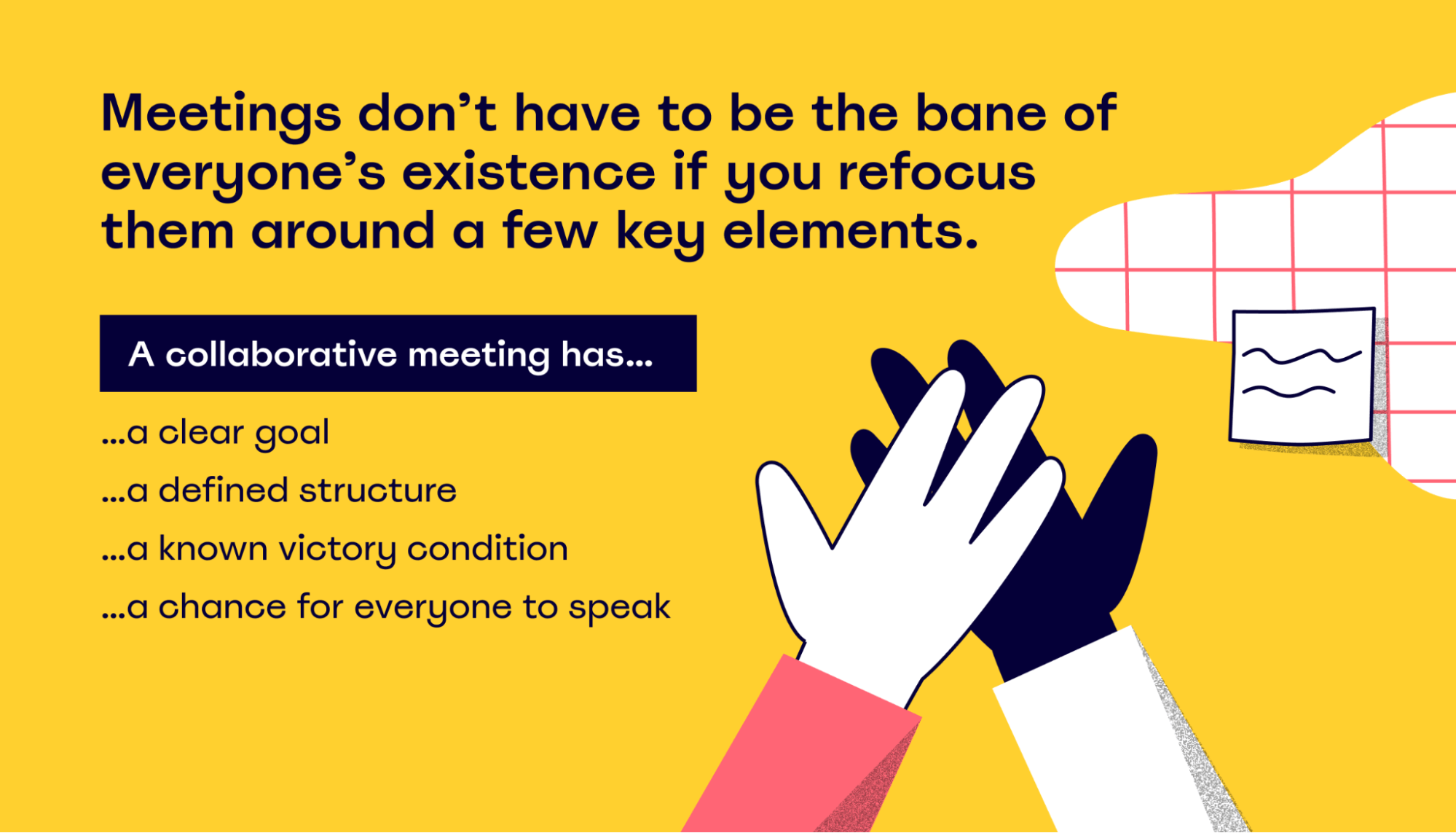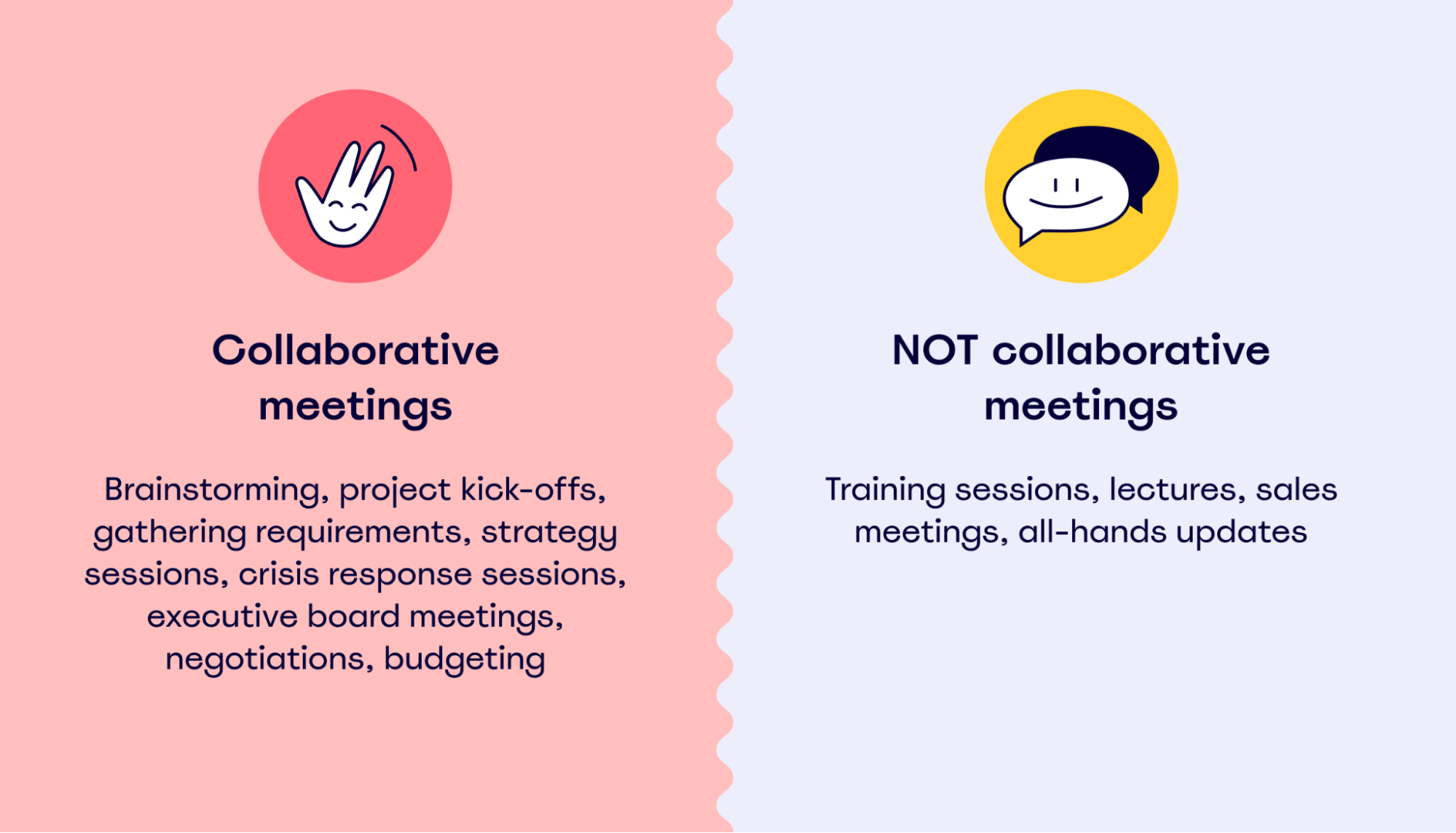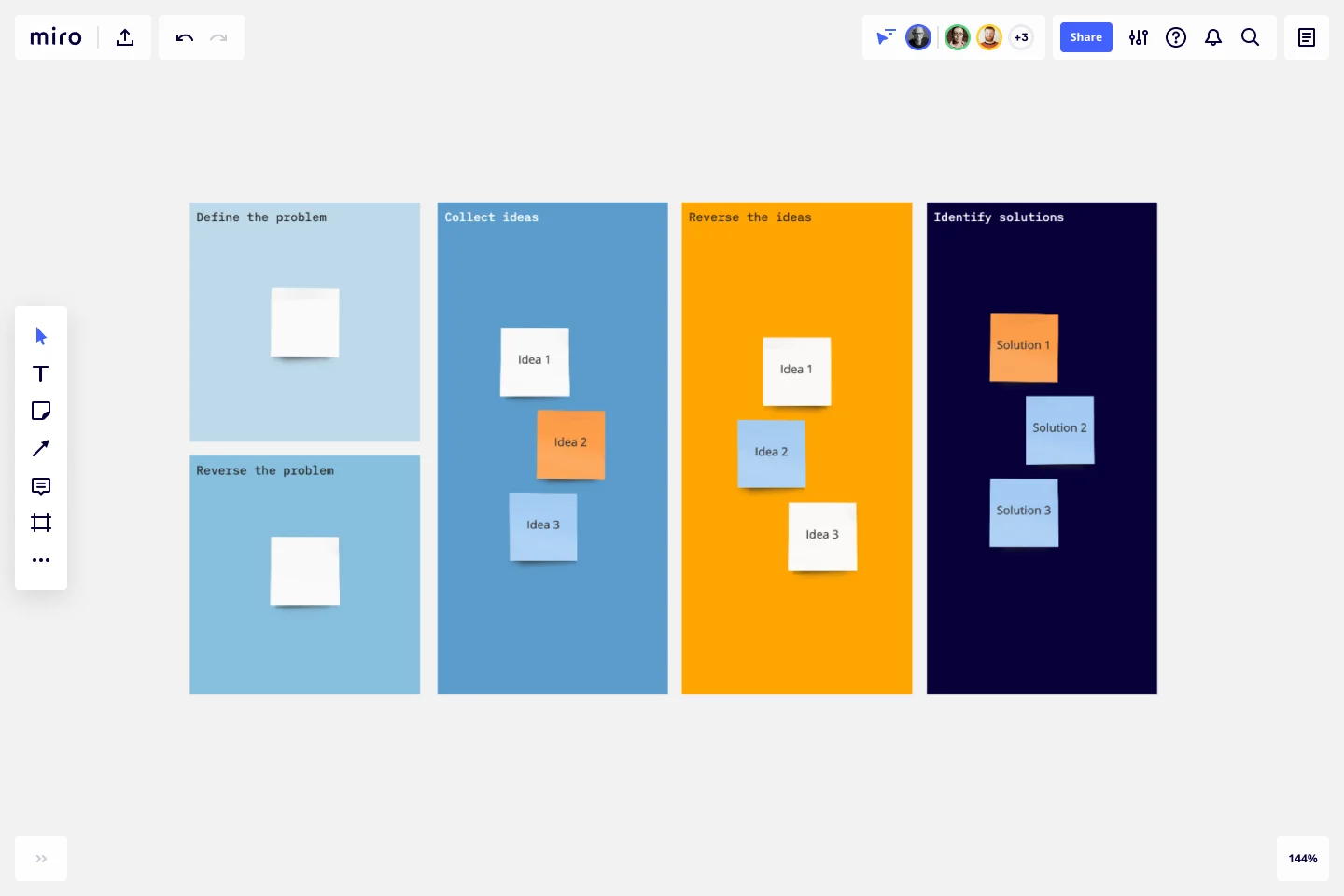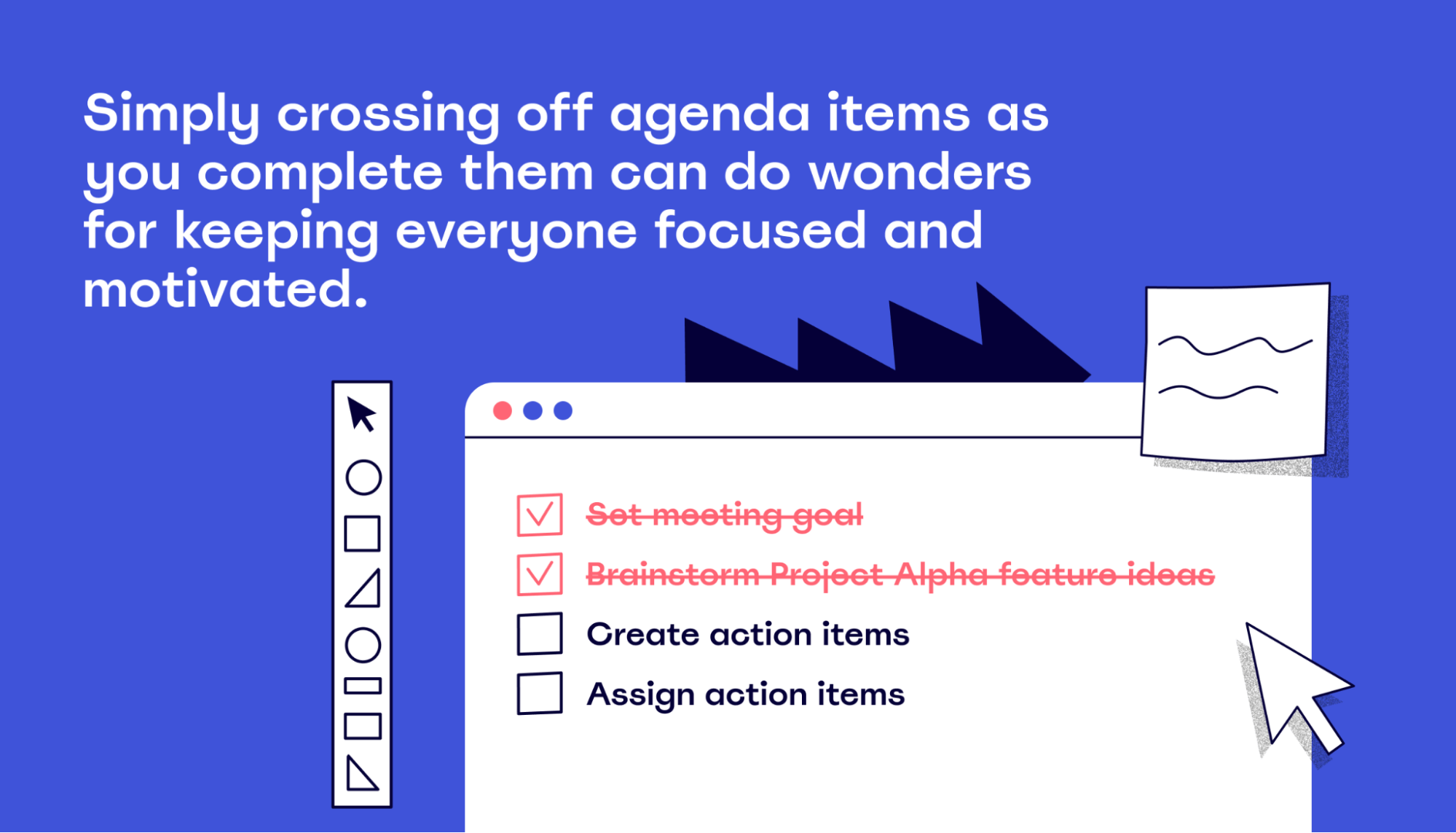In business, meetings can feel like wasted time more often than not.
It’s true that no team gets anywhere without a collaborative spirit and tight lines of communication. But there’s a reason for the saying, “too many cooks spoil the broth.” Trying to engage everyone in everything with no process and structure for doing so can lead to stagnation.
The signs of poor collaboration are obvious: everyone is behind schedule because they spend more time in meetings than doing their jobs.
So how do you foster collaboration — and collaborative meetings — that lift your team up instead of dragging them back?
What are collaborative meetings?
Collaborative meetings are meetings planned and run to maximize the participants’ ability to work together. Instead of being run from the top down, they’re designed around accomplishing goals while letting everyone have their say.
Collaborative meetings don’t follow a specific structure like Lean Coffee. The collaborative meeting movement is more of an ethos: all meetings must be necessary, efficient, and aimed toward the team succeeding together.
Meetings have such a bad reputation in the business world that people have proposed doing away with them altogether. But not all meetings can be replaced by Slack and email. Those which can’t, should be streamlined and optimized into the best possible use of everybody’s time.

The core idea is that a collaborative meeting should not just be about syncing up information. They need to involve a specific deliverable — a goal the participants work together to accomplish. When the meeting is over, everyone should have a clear idea of what their next steps are.
Much of the work of a successful collaborative meeting happens before the meeting begins. To avoid having one leader set the entire tone, participants receive the agenda and any necessary background before the meeting starts. During the meeting itself, the leader serves as a neutral facilitator.
Furthermore, collaborative meetings should never be dominated by a few people. Since everyone needs to leave with inspiration, everyone gets a chance to be heard.
Example use cases for collaborative meetings might include:
- Brainstorming. Your team needs ideas they can run with. Setting up a collaborative meeting gets everyone in the same (real or virtual) room and builds a psychologically safe environment that lets the ideas flow.
- Gathering requirements. When meeting with users to gather their stories and requirements, it’s important to make them feel like equal collaborators. Neither side is serving the other — you’re partners in accomplishing a goal.
- Project kick-offs. Every participant in a collaborative meeting should leave with their next tasks already in mind. It’s the perfect forum to start a new project with the right energy.

All of the above examples work best when the participants can communicate in real-time. Human brains are designed to converse immediately, without the delays of text chat. Without that element, it’s very difficult to align on a strategy or an idea.
Can you hold a collaborative meeting remotely?
With all that said, it’s not a prerequisite for every participant to be in the same physical space. In our age of remote and hybrid work, with teams distributed all across the world, that isn’t always possible. It’s easy to facilitate a remote workshop that participants love.
You do sacrifice some perks by not being in the same room, however. It’s harder to brainstorm without a whiteboard that everybody can see.

The solution is to work with innovative collaboration technology, like Miro. Our online digital whiteboard offers meeting participants a shared visual element on which to collect ideas and collaborate on action plans. It’s fully customizable to the needs of the team and simple to add elements such as comments and sticky notes that boost collaboration.
How do you hold collaborative meetings?
Any workplace can hold collaborative meetings — you just need to follow a few simple steps.
Come in with a plan
Planning a collaborative meeting starts with a goal. There must be a reason you called the meeting — what do you hope to have in hand by the time the meeting is over?
Use that goal to build an agenda. The agenda items, meeting format, and participant list should flow naturally from the goal. Structure the agenda as a series of steps toward resolving the main objective.
Once you have a completed agenda, send it to all participants. They should know the subject and purpose of the meeting before going in, along with any vital background information. Give them time to ask questions and suggest agenda items.
Keep it short
Collaborative meetings should be long enough to get the goal accomplished and no longer. The optimal timeframe will be dependent on the meeting type. Some focused brainstorming sessions can produce great results in as little as 20–30 minutes.
This may sound impossible if two-hour meetings have been your norm until now. But the cold truth is that most of the time in a two-hour meeting is wasted. Participants start to lose focus and may use the meeting time to do other tasks.
The key is to do as much work as possible ahead of time. Everything you can get done in the preliminaries is an item you don’t have to spend time on during the meeting itself.
Share the agenda, ask for questions, and bring participants up to speed. If participants are unlikely to know each other, a short icebreaker at the beginning of the meeting can help set the tone for further collaboration.
Focus on your goal
Start the meeting by briefly reiterating the reason you called it. A simple mission statement, like “We’re here to kick off the new project” or “We’re here to brainstorm ideas and assign tasks for the marketing campaign” will immediately get everyone on the same page.

Make sure that all participants agree on what the goal of the meeting is and know what action items they’ll be walking away with. Each time you begin a new agenda item, be sure everyone knows how it contributes to the wider goal.
Set a format for communication
It’s tempting to run a collaborative meeting in a completely leaderless format, where participants just talk when they have something to say. But that’s a dangerous approach. It often lets the loudest voices dominate the conversation and diminish other contributions, or means meetings degenerate into endlessly circular arguments.
Before the meeting starts, set the rules for how everyone will communicate. Explain how to raise an issue if you’re not scheduled to speak. Make it clear who has the power to mediate the discussion so it benefits everybody.
Your participants may raise issues that are not on the agenda, outside the meeting scope, or otherwise unproductive. If you need to cut them off, you can blunt the impact by creating a “parking lot” where their items can be saved for later discussion.
Know how you’ll make the decision
Your ultimate goal is a decision that gives every participant a clear path forward. Before you start the meeting, know how you’re going to reach that decision, and inform your participants.
Do you need consensus, or can you work with just majority approval? Is the decision collaborative or unilateral? If the decision is down to just one person, what do the participants contribute? If it’s a consensus decision, how will you take a vote?
Tips for collaborative meetings
These best practices will set your collaborative meetings up for success.
- Do as much work as possible ahead of time. Sometimes, a meeting can’t be an email, but email can still handle many parts of it. Send out the agenda, goals, and expectations at least a day before the meeting.
- Create a relaxed atmosphere. You’re not a drill sergeant. The more comfortable your participants feel, the more they’ll have to contribute. This also means taking time to invite less-talkative participants into the discussion.
- Keep attendance low. Don’t invite anybody to the meeting who doesn’t have an obvious reason to be there. If someone isn’t invited, it doesn’t mean you don’t value them, it just means their input isn’t relevant right now.
- Cross things off the agenda as you go. It sounds simple, but visually striking out agenda items builds a sense of accomplishment that unites everybody.
- Use meeting technology. The right software makes everything easier, especially if you’re hybrid or remote. For example, Miro’s meeting agenda template is a clear visual reminder of a meeting’s goals, agenda, and format.
Energize your meetings with these collaboration tips
Meetings don’t have to be tedious. With the right approach, they can be a powerful tool for building consensus and jump-starting motivation.
Apply our collaborative meeting tips at your next meeting, and see how much happier and more productive your attendees are.
Miro gives you the resources to create the perfect collaborative meeting atmosphere. Get started for free with our platform today.






